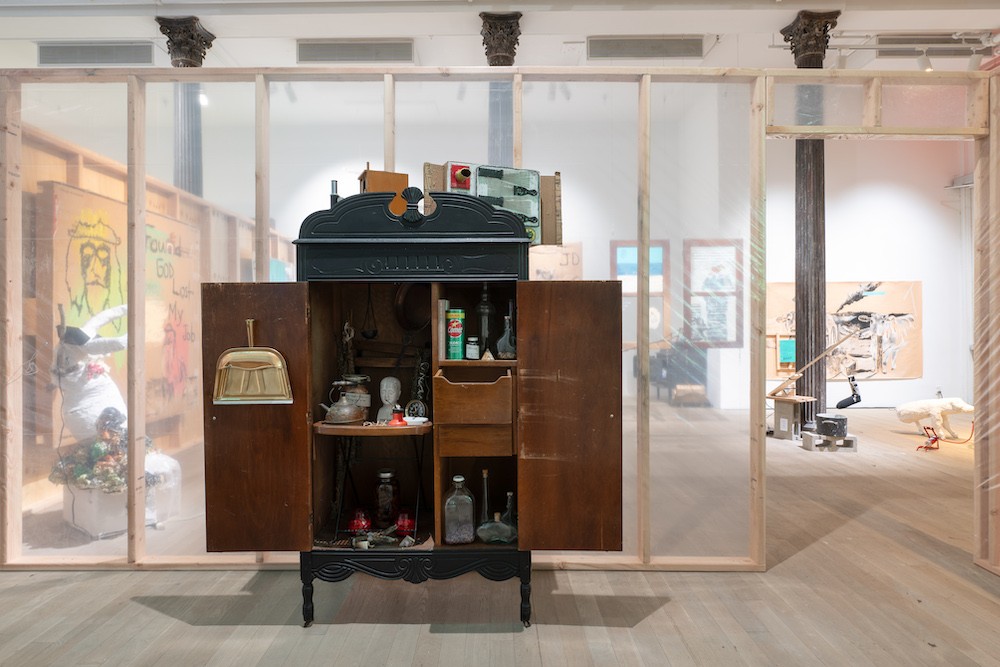Char Jeré '23 Unveils Solo Exhibition at Artist Space
Sound Art alum Char Jeré '23 has unveiled their debut New York City solo exhibition at Artists Space, Zoo or an Orchestra, an exploration of the nonlinear temporality within the African diaspora through various art forms. The exhibition, which opened on December 13, 2023, will be available for viewing through February 17, 2024.
Zoo or an Orchestra is a rich multimedia installation-opera in four acts, using both found and archival items. Organized into four rooms, the work is a reflection on the memories we share with those we briefly meet, others we’ve never met, those who we’ve known for a long time, or the ones we’ve yet to meet in the future.
The first space through which one enters Zoo or an Orchestra is a storefront resembling Jeré's grandfather's grocery store in Mississippi. Jeré’s grandfather, from Yazoo City, forms a fundamental inspiration for the exhibition. He was a successful farm owner for over two decades when Black land theft in the south was extremely pervasive.
“He opened one of the only grocery stores there at the time and it doubled as a third space for community exchange," said Jeré. "Elders would gather in the back telling stories and playing cards, while the kids ran around out front.” However, at some point, Jeré’s grandfather gave up everything to find God. “Religion, another type of technology, convinced him that he couldn't find God with a farm or a store so he sold everything and died with his religion but not much else,” Jeré said.

Jeré's opening storefront leads into Act Two of the exhibition, a room resembling a defunct grocery store filled with books and booklike objects made from materials as varied as wax, ceramic, and resin. Visitors are encouraged to use a document scanner to scan the books on display, which draw their titles from A Working Bibliography on the Negro in the United States, a 1969 work compiled by Dr. Dorothy Porter Wesley. Porter Wesley curated this array of research tools in response to the Dewey Decimal System's significant neglect of Black history and culture, which it reduced to mere subjects like colonization and slavery under classifications 325.26 and 326. Conducting most of their scholarly work at Howard University, Porter Wesley's efforts were instrumental in establishing the foundation of African American Studies.
The next room is fashioned into a laboratory where books and herbs are being distilled into essential oils, featuring automated sound objects and instruments creating a spatialized symphony.
“The sound I've created is mimicking movement or migration,” Jeré said. “The radio is automated to come in and out like stations on the road.”

The final space presents a surreal environment with antique televisions, mirrors, drawings and sculptural creatures set against Jeré's Periodic Table of Black Revolutionaries.
“The last space is a pasture of memories or mythology,” Jeré said. “I call the creatures that live there the keepers. They are the protectors of the pasture and the keepers of my ancestors.” These multisensory rooms, blending sound, sculpture, and filmmaking, reflect on the shared memories and evolving relationships between race and technology, the exhibition’s essential junction.
“Race is a technology entangled in a mess of other constructs,” Jeré said. “Ruha Benjamin asks, 'Who gets to define the problem that technology is able to fix?' Oftentimes I find myself walking around in a world that not only doesn't resonate with me but more terrifyingly feels like it's actually trying to kill me, as Lucille Clifton writes. That exclusion and threat is deliberate by design. Learning basic electrical and computer engineering feels like a survival technique at this point. The more I learn about these fields, the "black box" starts to become more discernible and less charismatic. My background in data science was primarily focused on ethical design and the importance of community involvement so I try to build worlds that are approachable and interactive.”
When asked how they decided on the exhibition’s title, Jeré shared that, to them, Zoo or an Orchestra is more like a state of mind and a measurement tool, dealing with human and nonhuman interactions. “That discrepancy that tends to divorce humans from the natural world can feel so arbitrary and careless, leading to some rather cruel behavior.”

Jeré is still thinking about their next move as a sound artist, but they are sure their art will continue to "call for the protection and freedom of all people who have been and continue to be oppressed by punitive systems and nefarious technologies."
Exhibition support for Zoo or an Orchestra is provided by Candy and Michael Barasch, Olivier Beggruen, Bernard I. Lumpkin and Carmine D. Boccuzzi. Additional in-kind support is offered by River East Elementary School and donateNYC. This project was supported, in part, by a Foundation for Contemporary Arts Emergency Grant.
Char Jeré is an Afro-fractalist whose work focuses on non-linear time created within the African diaspora. Their work is centered on the relationship between race and technology in antiquity and throughout modernity. Char Jeré lives and works in Brooklyn, New York. They received their MS in Data Analytics and Visualization from Pratt Institute and are currently working on their MFA in Sound Art from Columbia University.
